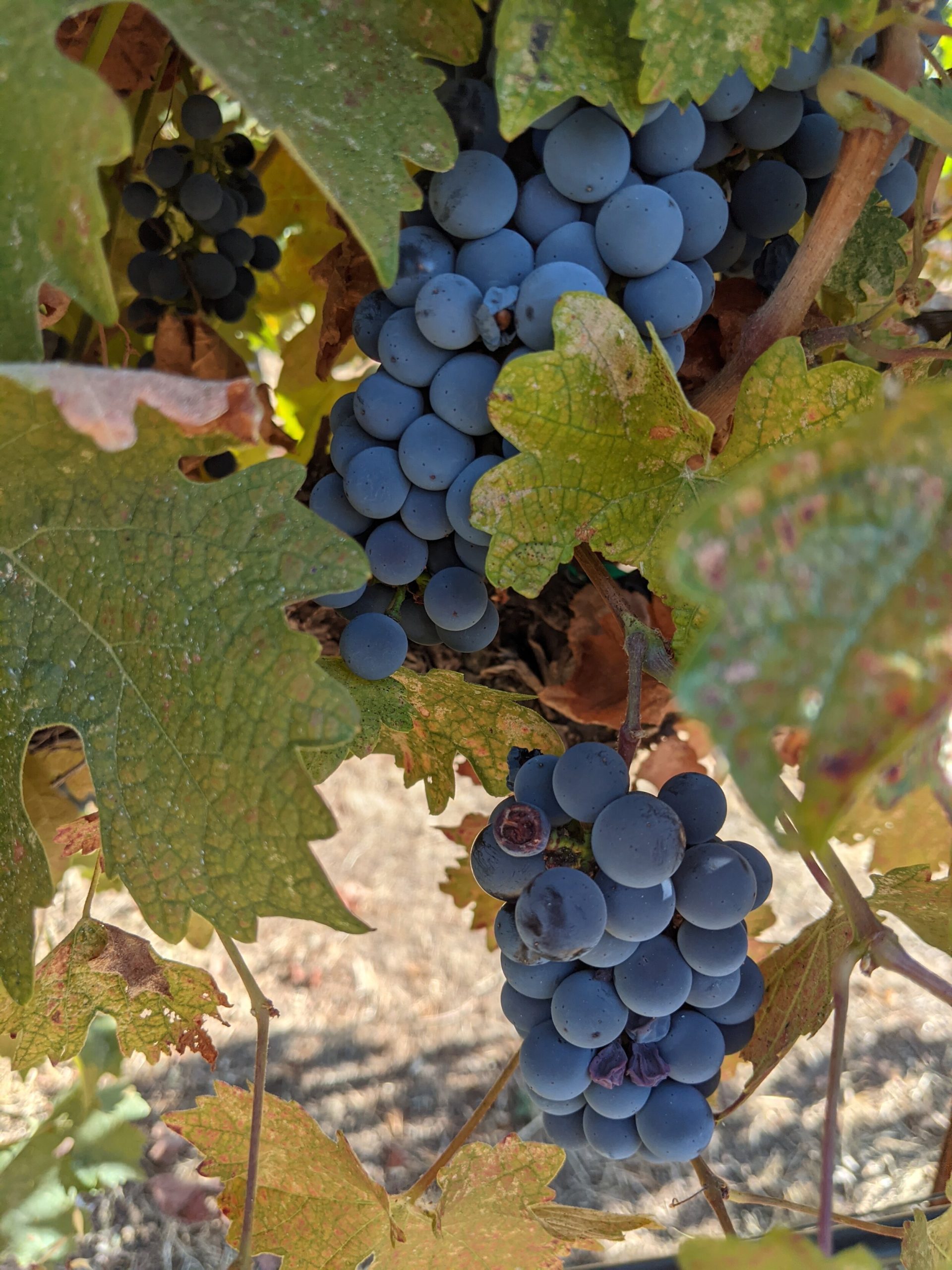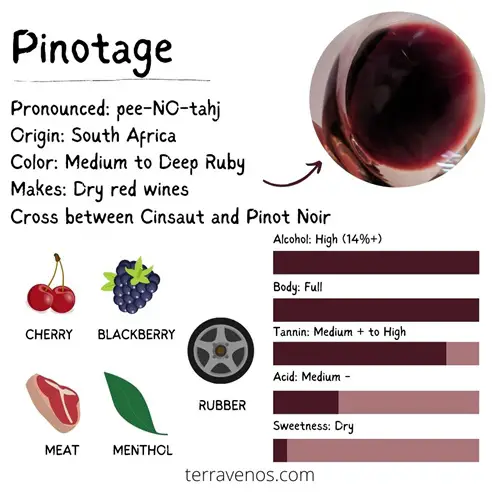
Where Do Wine Grape Names Come From?
Ever look at a bottle of wine and wonder how a grape got its name? Most grapes claim their titles from a physical attribute – something akin to last names like ‘Carpenter’ or ‘Johnson’ in English – not terribly original, but still, they offer little clues about the grape itself.
But as you can imagine, with an 8,000-year history, the crisscross of cultures and civilizations also plays a role, as does the clever botanist or two.
Here’s a fun list of 13 grape names along with their origin stories.
1. Muscat of Alexandria

It’s suiting to start with Mother Muscat, an ancient white grape variety from the Mediterranean that’s considered one of the most historic grapes still living it up in the vineyard and doing her thing.
The old gal won’t quit.
For the word ‘Muscat’, theories vary. Perhaps it refers to a derivative word in Persian, Greek, or Latin. In Italian, the word mosca for fly may be a nod to the fruit flies attracted to the sweet grapes.
Or perhaps it comes from the city of Moscat, in the Gulf of Oman, or the city of Moschato, in Greece.
Muscat of Alexandria is believed to have been the wine grape enjoyed by Cleopatra, and grown around the ancient Egyptian city of Alexandria.
The exact origins may be lost to time, but that doesn’t make it any less intriguing to imagine our ancestors sipping Muscat on a wild Mediterranean coastline in a distant, faded age.
2. Greco di Tufo

Whenever I hear Greco di Tufo, I conjure up images of marble Renaissance statues of unclothed men sculpted like Olympian gods.
Whatever helps you remember, right?
Greco di Tufo the grape and Greco di Tufo the wine-producing region are at home in southern Italy’s Campania, some 30 kilometers from Mount Vesuvius.
THE Vesuvius. 🤯
Tufo comes from the township by the same name, which gets its name from the volcanic rocky subsoil throughout in the region called ‘tuff’. Other grape varieties have carried the name Greco throughout the centuries, so put them together and you have Greco di Tufo.
Check out this delightful interview from a Greco di Tufo wine producer to learn more.

My favorite line:
“Killing people was okay. Killing vines was a ‘no no’.”
That’s just quality storytelling right there.
3. Nebbiolo

There’s little agreement about the name Nebbiolo, the grape grown in Northwestern Italy and used in Barolo wines.
Nebbiolo may come from the word nebbia, or fog in Italian, which is common during harvest season in Piedmont.
Or, perhaps the name refers to the dusty, fog-like veil that covers the berries as they mature.
What’s not up for discussion is Nebbiolo’s claim to fame.
Some will say that Nebbiolo has nothing to do with the grape’s appearance or climatic conditions, but rather that the wine has a long heritage in the royal courts of Europe, toasted by the nobility.
Get it? (Noble / Nebbiolo)
As the saying goes…
Barolo is both the king of wines and the wine of kings.
4. Sauvignon Blanc
Perhaps you’ve cracked open a crisp bottle of New Zealand Sauvignon Blanc, the world’s major exporter of this fruity white wine. Zippy, refreshing, and oh-so easy on the lips, Sauvignon Blanc may have earned its fame thanks to our adept Kiwi winemakers, but the grape’s home was originally central France.
A wildly popular variety in its own right, Sauvignon Blanc first emerged in the 1500s. The word Sauvignon is a combination of sauvage (wild) + vigne (vine). Blanc (white) refers to the berry’s color.
(Check out this Sav Blanc wine guide for more.)
5. Merlot

Ah! Merlot! A member of the Bordeaux wine grape family and one of my favorite grapes to work with, Merlot has deep purple, almost blackberries.
History mentions Merlot under the synonym Merlau back in the 1700s. It’s believed that Merlau is the diminutive form of the local word for blackbird.
Blackbird and blackberries, see the connection? (Here’s what you need to know about Merlot wine.)
6. Petit Verdot
Another of my personal loves and also part of the Bordeaux clan. Petit Verdot is a finicky grape. Petit (small) and Verdot (green), claims its name from how it ripens – or, in this case, doesn’t.
When the other grapes in the vineyard have already been harvested, crushed, and fermented, our tiny PV is still swinging in the vineyard, doing its thing and accumulating sugar.
We love all our grapey children equally, including PV. This is the vitis equivalent of adult offspring who just need a little more time at home before launching into the world.
They’re still ripening, too. The parallels are uncanny.
This calls for more wine!
7. Tempranillo

On the opposite end of the spectrum from PV, we have Tempranillo, the black Spanish grape that forms the backbone of Rioja wines. A diminutive form of the word temprano, or early, in Spanish, Tempranillo matures early in the season, oftentimes weeks before other varieties are ready.
Helpful Tip: Here’s a complete guide to Tempranillo wine.
8. Pinot Noir

At home in Burgundy, Pinot Noir is an old grape variety that’s long been under the careful watch of monks. Pinot comes from the word pinecone, a physical reference to the tight, pinecone-shaped grape clusters.
Noir, or black, is a nod to the grape’s purple color.
Genetic mutations through the ages have given rise to Pinot Gris, whose offspring have gray-like colored berries, and Pinot Blanc, which sports green berries.
Helpful Tip: Go visit the Pinot Noir wine guide here.
9. Müller-Thurgau

If you’ve never heard of Müller-Thurgau, you probably opened a bottle of German Riesling, decided it was delicious, and stopped there.
Wise choice.
Müller-Thurgau plays an important role in high-volume wine production in Germany and is actually the second most planted grape in Germany after Riesling.
This hardy white grape will thrive in a range of climates and soils, making non-descript low acid, fruity white wines.
Dr. Hermann Müller, a researcher at the Geisenheim Institute, developed the grape through a breeding program in the 1880s crossing Riesling and Madeline Royale. He was originally from the Swiss canton of Thurgau.
So today we have the grape Müller-Thurgau.
Jargon Alert: A grape cross results from breeding to separate grape varieties from the same species. Perhaps the most famous cross is Cabernet Franc and Sauvignon Blanc. They crossed in the wild to produce Cabernet Sauvignon. Who knew?
10. Chardonnay

According to this impressively comprehensive treatise on the naming conventions of Chardonnay, it seems that…
“While many people assume the grape was named for the village, the relationship between the names is murky at best.”
The grape’s been grown in too many places and used too many alter-egos to claim a single patrimony with any confidence.’
Umm… Who knows?
I thought that Chardonnay claimed its name from the medieval Latin for thistle, which is given to a town in southern Burgundy (home to exquisite Chardonnay). The Latin is Cardonnacum, meaning “place of thistles,” which shifts to chardon in French.
But…
In 1898 wine authorities (a.k.a. bureaucrats) standardized the grape’s name to Chardonnay. Prior to this, the grape flitted about under different aliases: Chardenet, Chaudenet, Chardonnet, or Chardenay.
Maybe it’s thistly. Maybe not.
11. Pinotage

This signature black grape of South Africa is the result of a breeding program that wanted to get the aromatics and finesse of Pinot Noir along with the disease resistance and heartiness of Cinsault (locally known as Hermitage) back in 1924.
Pinotage gets its name as a portmanteau of Pino + tage.
I actually prefer the name Pinotage to Müller-Thurgau, which doesn’t exactly roll off the tongue. I’m guessing a snap poll of marketers would agree with me.
Even though Pinotage failed to produce anything like Pinot Noir, the wines have found a home with BBQ lovers the world over with their rich, deep black fruit and spiciness. Pinotage has a spotty reputation.
You either love it or hate it. If you’ve never tried it, then go out and get a bottle today!
12. Zinfandel
Zin suffered a case of mistaken identity. In Italy, Zinfandel goes by the name Primitivo, coming from the Latin primo, or first, referring to its early ripening. But we don’t use Primitivo in the US.
How did we go from Primitivo to Zinfandel?
That’s a bit of a linguistic stretch by any measure, so we need to go back in history a bit.
At one point, the Austrian Hapsburgs controlled the area around Venice and down into Southern Italy. Their imperial nursery collected vines from the Italian peninsula, cultivating them back in Vienna.
In a picture, we have 1700 on the following map:

Fast forward 100 years.
A horticulturalist in the US imported a shipment of these nursery cuttings in the early 1800s.
The shipment referenced a German vine called Black Zierfandler. Zierfandler is the local name for Sylvaner, a widely-grown white grape in Germany. Over the centuries, Zierfandler shifted to the English word Zinfandel.
It wasn’t until 1994 with the advent of DNA testing that researchers were able to prove that California’s Zinfandel and Italy’s Primitivo were one and the same. (Here’s a full post on Zinfandel.)
13. Malbec
The spiritual home for this black grape may be Argentina, but its true heritage lies in southwest France, in the Cahors region.
There, the grape goes by the local name of Côt, a geographical reference to Cahors.
Tip: Learn more about Malbec wine with this helpful post.
Two popular but equally questionable theories attempt to explain the origin of Malbec.
- Theory 1: A Hungarian peasant by the name of Monsieur Malbeck cultivated and spread the variety across France. This is unlikely because the name Côt was and still is deeply embedded in the region’s lexicon.
- Theory 2: The word is a contraction that stems from the French words “mal bouche,” meaning “bad mouth,” a reference to how many French winemakers disliked working with the grape. In Malbec’s defense, back in the day, the French were cultivating Malbec in a marginal growing climate at best. Lucky for us, Malbec made the move to Argentina and the rest is history.
Pick your poison. Either theory may be true.
Final Thoughts – Wine Grape Names
What’s in a name? Physical trait. Portmanteau. Imperial clerical error. Everyone loves a good story.
Chances are your little fermented grape has one or two waiting for you to discover, so pop open a cork on new-to-you bottle and sip through history!
Thirsty for More?
Check out the curious history behind Madeira wine and how it almost became British.
Here’s an exhaustive list of wine names, A-Z.




